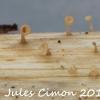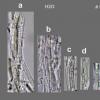
25-01-2017 17:50
Roland LabbéBonjour !Voici un disco inconnu de nous. Nous avon

02-02-2017 20:45
 Angel Pintos
Angel Pintos
On Ruscus aculeatusPseudothecia inmersed, visible

31-01-2017 06:51
 Viktorie Halasu
Viktorie Halasu
Good morning,I was given exsiccate of this nice di

01-02-2017 01:30
Roland LabbéBonjour !Voici un Arachnopeziza que nous croyons �

31-01-2017 19:40
 David Vaudoré
David Vaudoré
Bonjour à tousJe vous soumet ce champignon trouv�

01-02-2017 10:23
Björn NordénAnyone here who happens to know the etymology of t
Discomycète inconnu ? 50662
Roland Labbé,
25-01-2017 17:50
Voici un disco inconnu de nous.
Nous avons eu de la difficulté à comprendre et à décrire son excipulum, tellement il est petit.
Vos suggestions sont les bienvenues pour nous aider à le résoudre.
Merci de votre aide !
Roland
Données :
Substrat : tige d'herbacée
Asques cylindriques, élargies légèrement vers l'apex, à 8 spores bisériées, avec crochet à la base et appareil apical petit et amyloïde, 36-47,8 x 3,9-5,1 µm
Paraphyses très abondantes, cylindriques-obtuses, septées jusqu'à la mi-hauteur et doublement ramifiées à la base, à contenu huileux faiblement jaunâtre sans ou avec très peu de guttules ou granulations (exsiccatum), 45-51 x 2-2,4 µm, dépassant les asques de 3-5 µm
Spores cylindriques-fusiformes et obtuses aux bouts, parfois très légèrement arquées, lisses, non septées, finement guttulées aux pôles ou avec gouttelettes dispersées, hyalines, 7,8-10 x 1,6-1,9 µm, Q = 5,2
Excipulum possiblement à 3 couches à cause des couleurs différentes dans le Rouge Congo SDS: une rouge, la plus externe, une hyaline gélatinisée et une autre centrale (medulla?), dont les dimensions sont assez semblables si ce n'est des hyphes hyalines descendant verticalement du sous-hyménium (medulla?) dont la paroi apparaît un peu plus mince et dont le diam. est légèrement plus petit (1,84-2,67 µm de diam. contre 2,2-2,55 µm pour celles gélatinisées hyalines et 2,1-3,2 µm pour celles de la partie la plus externe colorées).
Poils marginaux très abondants, en palissade flexible, cylindriques-obtus, septés jusqu'à mi-hauteur, doublement ramifiés à la base, de morphologie et dimensions semblables aux paraphyses
Poils du revêtement externe apprimés, semblables aux poils marginaux
Michel Hairaud,
25-01-2017 17:56

Re : Discomycète inconnu ? 50662
Bonjour Roland,
As tu cherché dans le genre Cyathicula ?
Amitiés
Michel
As tu cherché dans le genre Cyathicula ?
Amitiés
Michel
Roland Labbé,
25-01-2017 21:20
Re : Discomycète inconnu ? 50662
Hi Michel !
Dans une clé des Cyathicula, j'arrive directement à C. starbaeckii.
Tous les caractères coorrespondent, sans exception.
Ce disco pâle a un col blanc pulvérulant à la marge.
Ce que l'on voit très bien sur la photo macro.
Je crois que ce serait cette espèce.
Je vous remercie, salutations !
Roland
Dans une clé des Cyathicula, j'arrive directement à C. starbaeckii.
Tous les caractères coorrespondent, sans exception.
Ce disco pâle a un col blanc pulvérulant à la marge.
Ce que l'on voit très bien sur la photo macro.
Je crois que ce serait cette espèce.
Je vous remercie, salutations !
Roland
Roland Labbé,
26-01-2017 16:02
Re : Discomycète inconnu ? 50662
Michel,
Dans notre planche micro, nous avons trois photos qui représenteraient l'excipulum de ce Cyathicula. Nous ne pensons pas que c'est exact, car les Cyathicula devraient avoir seulement un excipulum '' glassy appearance ''. Il y en a peut-être qui représente les hyphes du pied.
Seriez-vous en mesure de nous indiquer quel est la ou les bonnes photos qui correspondraient à cet excipulum ?
Je vous remercie de nouveau !
Roland
Dans notre planche micro, nous avons trois photos qui représenteraient l'excipulum de ce Cyathicula. Nous ne pensons pas que c'est exact, car les Cyathicula devraient avoir seulement un excipulum '' glassy appearance ''. Il y en a peut-être qui représente les hyphes du pied.
Seriez-vous en mesure de nous indiquer quel est la ou les bonnes photos qui correspondraient à cet excipulum ?
Je vous remercie de nouveau !
Roland
Michel Hairaud,
27-01-2017 09:13

Re : Discomycète inconnu ? 50662
Bonjour Roland,
Le découpage des images ne facilite pas trop l'interprétation, mais à priori je ne vois pas de contradictions.
Dommage peut être de ne pas préférer les préparations dans l'eau, en l'occurrence, cela permettrait peut être de vérifier la présence d un pigment intercellullaire ou non dans la chair et d'avoir plus de garanties sur l'espèce. J'avoue que j'hésite au vu de la macro entre starbaecki et une autre espèce comme simplement cyatoidea
Amitiés
Michel
Le découpage des images ne facilite pas trop l'interprétation, mais à priori je ne vois pas de contradictions.
Dommage peut être de ne pas préférer les préparations dans l'eau, en l'occurrence, cela permettrait peut être de vérifier la présence d un pigment intercellullaire ou non dans la chair et d'avoir plus de garanties sur l'espèce. J'avoue que j'hésite au vu de la macro entre starbaecki et une autre espèce comme simplement cyatoidea
Amitiés
Michel
Roland Labbé,
27-01-2017 11:28
Re : Discomycète inconnu ? 50662
Merci, Michel !
Croyez-vous que la marge de l'apothécie (exsiccatum) sur la photo a un court col blanc et pulvérulent ?
Roland
Croyez-vous que la marge de l'apothécie (exsiccatum) sur la photo a un court col blanc et pulvérulent ?
Roland
Michel Hairaud,
27-01-2017 13:45

Re : Discomycète inconnu ? 50662
l'exsic a du être réhydraté ?
Je ne distingue pas d e pulvérulence particulière. La couleur blanche de la marge s'applique à d'autres espèces . Il n'y avait pas de cristaux en surface ? (Ce n'est d'ailleurs pas la seule espèce qui en comporte)
Michel
Roland Labbé,
28-01-2017 05:52
Hans-Otto Baral,
03-02-2017 09:04

Re : Discomycète inconnu ? 50662
C. starbaeckii is a species that has deeply cupulate apothecia like a wine glass, and the inner excipulum is grey-brown, unilke here.
I concur with Michel: C. cyathoidea. But this is a complex of taxa that cannot be distinguished by morphology alone and await to be monographed by molecular methods.
Zotto
I concur with Michel: C. cyathoidea. But this is a complex of taxa that cannot be distinguished by morphology alone and await to be monographed by molecular methods.
Zotto
Michel Hairaud,
03-02-2017 09:50

Re : Discomycète inconnu ? 50662
Bonjour Roland,
Désolé je n'avais pas vu cette nouvelle intervention . Je n'aurais pas su en dire davantage avec ces micros.
Merci à Zotto pour sa réponse , donc.
Michel
Désolé je n'avais pas vu cette nouvelle intervention . Je n'aurais pas su en dire davantage avec ces micros.
Merci à Zotto pour sa réponse , donc.
Michel
Roland Labbé,
04-02-2017 05:49
Re : Discomycète inconnu ? 50662
Merci Michel et Zotto de votre aide.
Nous avons adopté C. cyathoidea.
Amitiés !
Roland, Jacqueline et Jules
Nous avons adopté C. cyathoidea.
Amitiés !
Roland, Jacqueline et Jules




